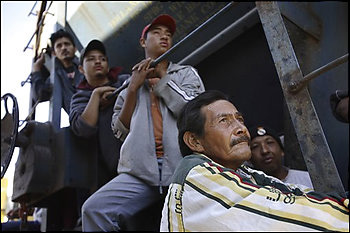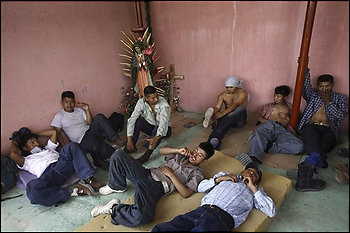
|
 |
 |
 News Around the Republic of Mexico | April 2008 News Around the Republic of Mexico | April 2008  
Central America Migrant Flow to US Slows
 Olga R. Rodriguez - Associated Press Olga R. Rodriguez - Associated Press
go to original


| | Illegal immigrants travel in a train heading north, on their way to the U.S. in Arriaga, southern Mexico, Saturday, Feb. 2, 2008. (Rodrigo Abd/AP) | 
| | An illegal immigrant from El Salvador talks to Mexican police at a migrant shelter after being robbed, in Arriaga, southern Mexico, Wednesday, Jan. 30, 2008. (Rodrigo Abd/AP) | 
| | Illegal immigrants from Guatemala, on their way to the U.S., rest while waiting to jump into a train northbound at a migrant shelter in Ixtepec, southern Mexico, Thursday, Jan. 31, 2008. (Rodrigo Abd/AP) | 
| | An illegal migrant, on his way to US, waits for the train to leave, in Ixtepec, Mexico, Thursday, Jan. 27, Wednesday, Jan 30, 2008. (Rodrigo Abd/AP) | 
| | Honduras' Alma Cruz, 35, who lost her leg five years ago on a train while trying to reach the U.S., watches TV at a migrant shelter in Tapachula, southern Mexico, Tuesday, Jan. 29, 2008. (Rodrigo Abd/AP) | | |
Arriaga, Mexico - For thousands of illegal immigrants from Central America, the long journey to the U.S. starts here, on the groaning back of a freight train they call The Beast.

But these days many don't get too far.

Central Americans without documents now face increased security within Mexico, including checks on the train for stowaways. It's also harder for them to head north once they cross into Mexico because of hurricane damage to the train tracks.

The result: The number of non-Mexican migrants stopped by the U.S. Border Patrol has dropped almost 60 percent from 2005, despite increased detention efforts. About 68,000 non-Mexican migrants — mostly Central Americans — were detained last year, compared to 165,000 in 2005. Non-Mexicans make up about 10 percent of all migrants caught by Border Patrol officers.

Mexico itself is also seeing fewer illegal immigrants — 120,000 were arrested last year, a 50 percent drop from 2005, when Hurricane Stan hit and destroyed the railroad, according to the National Immigration Institute. Since President Felipe Calderon took office two years ago, Mexico has added more soldiers and federal police on its border with Guatemala and more immigration and military checkpoints throughout the south.

Despite its efforts to secure its own southern border, Mexico does not try to stop its own citizens from crossing north illegally into the United States, beyond pursuing drug and people smugglers. By law, Mexico notes, Mexicans can go wherever they want within the country, including the border. They don't break any laws until they are on U.S. soil.

Many Mexicans are also sympathetic to illegal immigrants from Central America, but the issue still causes some tensions that echo the U.S. debate. Isaac Castillo, owner of the Hotel La Posada in Arriaga, argues that Central American immigrants often end up working in Mexico, where wages can be double the few dollars a day they might earn at home.

"The problem isn't just in the U.S., but in Mexico, because a lot of Central Americans want to stay here and compete with Mexicans for jobs," he said.

The crackdown on Central American migrants has left them searching for new routes. Some pay smugglers $7,000 to go by boat into southern Mexico, then hide in tractor-trailers heading north.

These boats and trucks try to evade highway checkpoints set up every few miles alongside most of Mexico's southern roadways. But migrants have been crushed to death when false floors collapsed under the weight of freight, and 22 Salvadoran migrants drowned in an October shipwreck off the coast of southern Oaxaca state.

For those Central American migrants unable or unwilling to risk the sea, a cargo train — The Beast — remains the only option for the 2,000-mile trip to the U.S.

The long trek begins at the Suchiate river, on the border with Guatemala, where for $1 they cross on makeshift rafts into sweltering jungles.

Then they hike along the destroyed, sun-scorched train tracks to Arriaga for up to nine days. Arriaga, 200 miles from the Guatemalan border, is the closest place to hop a train since Hurricane Stan destroyed the Chiapas-Mayab line.

As they head north, they pay off thieves, immigration officials, police and railroad employees.

Juan Gabriel Ramos, a Guatemalan 17-year-old trying to join his mother in California, said he bribed a Mexican federal police officer and an immigration agent before even making it to Arriaga.

"They both told me that if I didn't give them money they would send me back to Guatemala," Ramos said.

When they're caught, migrants say they're often abused by Mexican authorities. In one notorious case last year in the northern city of Saltillo, migrants complained to the National Human Rights Commission of rectal exams done by immigration officials who said they were checking for cholera.

"The mistreatment of migrants here is brutal, and no one does anything about it because everyone sees them as booty," said Heyman Vasquez, a Roman Catholic priest. He estimated 80 percent of migrants are robbed before they arrive at his two-room shelter in Arriaga.

The slowdown in immigrant traffic is notable in Arriaga, a town of corn and sorghum farmers. Only a few clusters of Central American men and women linger around the mostly abandoned, graffiti-covered train station, where they wait for the first train they can grab. Many stay at a local migrant shelter, watching television or sharing stories of abuse.

Sitting on a cracked sidewalk outside the shelter, one Nicaraguan man told of the time he saw a group of criminals gang-rape a woman and shoot her boyfriend. A Honduran couple talked of fleeing their country after gang members killed their teenage daughter, and leaving their seven children, ages 18 to 1, in hiding.

It doesn't get any easier once immigrants hop a train. They must often bribe private guards and police stationed along the tracks. Many stowaways are too tired to hold on to the train and fall, losing limbs.

The trip itself can be deadly.

Jorge Guevara, a 21-year-old Salvadoran, said he first rode the train to the U.S.-Mexico border in 2001 and saw 20 people crushed, and probably killed, when cars derailed. He fled and never found out what happened.

"That accident left me in shock, but I kept going," Guevara said to a group of first-time migrants, listening intently. "One doesn't think about the danger, only about getting to the United States. Once I'm there, I'll think about it."

Guevara said he drove a forklift in Dallas until he was pulled over for a burned-out taillight and deported last year.

It took Milagros Rivera and her family a month to reach Ixtepec, just 85 miles north of Arriaga. By then, the 36-year-old from El Salvador said they had been robbed three times.

The first time was at the river crossing into Mexico. Soldiers demanded money before allowing her, her boyfriend, her 20-year-old son and her 18-year-old daughter-in-law to continue on.

About 50 miles later, gunmen held them up along the tracks, forced them to strip naked and took about $1,500 they had saved, Rivera said.

"It was a terrible moment because they took my daughter-in-law away, and we thought they were going to rape her," said Rivera.

The thieves ended up freeing the girl unharmed. But then they were robbed by a local police officer of the $40 they had collected begging on the streets.

Rivera said she is bound for Virginia, where friends have promised to help her find work.

"There is a lot of suffering," she said. "But the hope of reaching your destination helps you to keep going." | 
 | |
 |



